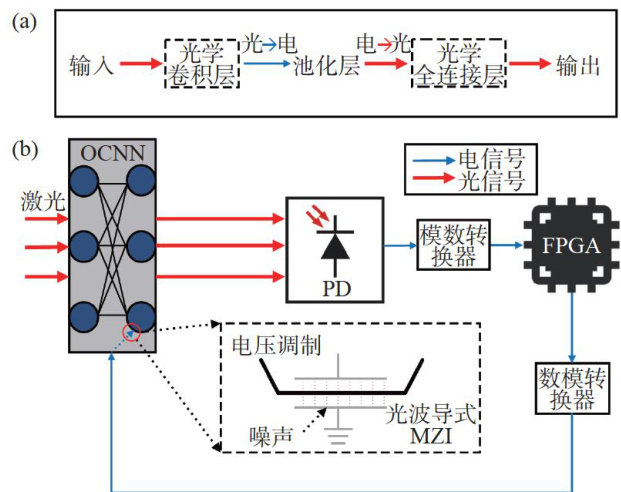光电混合的光学卷积神经网络的片上训练及其抗噪性


打开文本图片集
中图分类号:TP394.1:TH691.9 文献标志码:A doi:10.37188/CO.2025-0016 CSTR:32171.14.CO.2025-0016
On-chip training and its noise immunity for hybrid optical-electronic optical convolutional neural networks
SHAO Xiao-feng, SU Jing-yi, WANG Jin* (College of Telecommunication and Information Engineering,Nanjing University of Posts and Telecommunications,Nanjing21ooo3,China) * Corresponding author, E-mail: jinwang@njupt.edu.cn
Abstract: The hybrid optical-electronic optical convolutional neural network (OCNN) combines the parallel linear computation capabilities of photonic devices with the nonlinear processing advantages of electronic components,demonstrating significant potential in classification tasks.However,the fabrication inaccuracies of photonic devices and the circuit noise in FPGA-based backpropagation notably degrade the network performance. In this work, the hybrid optical-electronic OCNN is constructed, where the linear computations are performed by optical computing layers based on Mach-Zehnder interferometers (MZIs), while the pooling operations and the training process are implemented on the FPGA.This study focuses on the feasibility of onchip training on FPGA,analyzing the impact of noise on training performance and proposing the network optimization strategies to enhance the noise immunity of OCNN. Specifically,the noise immunity is improved by adjusting the pooling method and pooling size,and the Dropout regularization is introduced after the pooling layer to further enhance the model's recognition accuracy. Experimental results indicate that the proposed on-chip training scheme effectively mitigates errors caused by the fabrication inaccuracy in the photonic devices.However, the circuit noise remains the primary factor limiting the OCNN performance. Notably,under the high circuit noise conditions, e.g. when the standard deviation of MZI phase error caused by circuit noise reaches O.0o3, the combination of maximum pooling and Dropout regularization significantly improves the recognition accuracy of OCNN, which achieves a maximum of 78% . This research provides valuable insights for implementing on-chip training in OCNNs and explores new approaches for deploying hybrid optical-electronic architectures in high-noise environments.
Keywords:OCNN; on-chip training;Mach-Zehnderinterferometer
1引言
在过去几年,深度学习 (DeepLearning)在计算机视觉、语音识别和图像分类等领域取得了显著成果[1-2]。(剩余12102字)